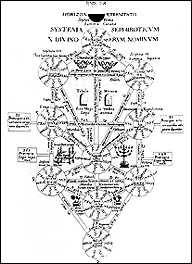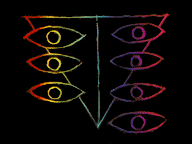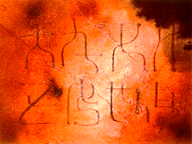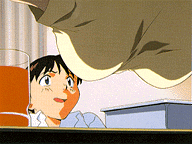Gainax's Neon Genesis Evangelion (continued) | |
  Systema Sephiroticum
  The 7 Eyes of God
  What is the Truth between God and man?
|
A Giant Robot X-Files? The Kabbalah needs a little discussion in any article on Evangelion. The diagram, "Systema Sephiroticum," (The Sephirothic System") that appears in Eva's opening credits over Misato's right hand (and on the ceiling of Gendou's office) was drawn by a German priest, Athanasius Kircher, in 1653 (We won't speculate on whether Kircher's brother Jesuits you saw in Shogun entrusted a copy to Anno's Tokugawa ancestors). Kircher's drawing was based on his study of the Kabbalah, which means "tradition" in Hebrew. The word "cabal" is derived from it, and with good reason: The Kabbalah is a highly esoteric strain of mysticism within Judaism that first arose in Spain in the twelfth century. The Kabbalah claims to be a collection of secret knowledge handed down directly from God to Adam to Moses that provides the initiate with the ability to approach God directly. The Kabbalah was originally based on what might be called a cryptologic premise, that Creation itself was a process involving the ten digits (as "divine numbers," or "sephiroth"), and the 22 letters of the Hebrew alphabet; together they constitute the "32 paths of sacred wisdom".  The Sephiroth later became associated
with facilities both human and divine--such as beauty, wisdom, and
glory--and was seen as the very framework, the model,
through which God had created both the human being and the
Universe--this framework is what the "Systema Sephiroticum" portrays.
The esoteric influence of the Kabbalah is seen most clearly in modern
Judaism inside Hasidic communities, but the Kabbalah has fascinated
scholars--from priests to psychologists such as Carl G. Jung, and
secret societies of every stripe since the close of the Middle Ages.
In Umberto Eco's ultimate secret society novel, Foucault's
Pendulum, a character insists that even the first automobile was
designed along the lines of the Sephirothic System--and indeed this
may be where we come into what the Kabbalah, motifs of which are
flashed at the opening of every episode of Eva, has to do
with the show. Ayanami Rei, one of the Evangelion pilots, refers in
episode 14 to the "entry plug" with which pilots are inserted into
their EVA units as "the throne of the soul," a very Sephirothic
concept. Most giant robots are in human shape, of course, but in
Evangelion this fact may be given mystical overtones as
well--not quite what people expected from Anno when he said that he
wanted to be liberated from the design constraints that would come if
Eva had been financed by a toy company! The Sephiroth later became associated
with facilities both human and divine--such as beauty, wisdom, and
glory--and was seen as the very framework, the model,
through which God had created both the human being and the
Universe--this framework is what the "Systema Sephiroticum" portrays.
The esoteric influence of the Kabbalah is seen most clearly in modern
Judaism inside Hasidic communities, but the Kabbalah has fascinated
scholars--from priests to psychologists such as Carl G. Jung, and
secret societies of every stripe since the close of the Middle Ages.
In Umberto Eco's ultimate secret society novel, Foucault's
Pendulum, a character insists that even the first automobile was
designed along the lines of the Sephirothic System--and indeed this
may be where we come into what the Kabbalah, motifs of which are
flashed at the opening of every episode of Eva, has to do
with the show. Ayanami Rei, one of the Evangelion pilots, refers in
episode 14 to the "entry plug" with which pilots are inserted into
their EVA units as "the throne of the soul," a very Sephirothic
concept. Most giant robots are in human shape, of course, but in
Evangelion this fact may be given mystical overtones as
well--not quite what people expected from Anno when he said that he
wanted to be liberated from the design constraints that would come if
Eva had been financed by a toy company! Evangelion is teeming with Hebrew
and Biblical lore besides the Sephirothic System, with the EVA units
possibly connected to the legend of the Golem, a giant artificial man
which does its creator's bidding, the mystical Hebrew calligraphy at the
very end of the opening credits resembling that found in the seventeenth
century "Book of Raziel," the Hebrew code-names given the "Angels," the
mysterious "remains of Adam," the quote from Genesis 2:8-9 that is the
apparent epigram of the series, the line from Browning that is the motto
of NERV, and the suggestion that the Angels' attacks were foretold by
the Dead Sea Scrolls, the oldest fragments of Jewish scripture,
discovered in 1947. Take Anno's remarks about how Evangelion
was going to involve some big questions about the truth between God and
man, and combine it with these mysterious, mystic clues scattered
throughout the series--already giving rise to many fan "theories" about
where Eva is leading--and it's not too much to say that those
who like The X-Files may find a lot to like here as well. Evangelion is teeming with Hebrew
and Biblical lore besides the Sephirothic System, with the EVA units
possibly connected to the legend of the Golem, a giant artificial man
which does its creator's bidding, the mystical Hebrew calligraphy at the
very end of the opening credits resembling that found in the seventeenth
century "Book of Raziel," the Hebrew code-names given the "Angels," the
mysterious "remains of Adam," the quote from Genesis 2:8-9 that is the
apparent epigram of the series, the line from Browning that is the motto
of NERV, and the suggestion that the Angels' attacks were foretold by
the Dead Sea Scrolls, the oldest fragments of Jewish scripture,
discovered in 1947. Take Anno's remarks about how Evangelion
was going to involve some big questions about the truth between God and
man, and combine it with these mysterious, mystic clues scattered
throughout the series--already giving rise to many fan "theories" about
where Eva is leading--and it's not too much to say that those
who like The X-Files may find a lot to like here as well.
|
  Eva Unit 02
  Misato starting breakfast with beer
  Fan Service!
|
A Robot and Cute Girl Show "We're not computers, Sebastian," Roy Batty admonishes in Blade Runner, "We're physical." Physical is the word to describe the terrific robot combat in Evangelion: in episode 2, Shinji's Eva-01 unit fights the Angel not with a swarm of homing missiles as in Macross, but with its fists and feet--not Bruce Lee stuff either, but the savagery of a barroom brawl. The EVA is trying to beat the Angel to death, and the collateral damage to the city of Tokyo-3 is high. Unlike the chunky, linebacker mobile suits of Gundam (They appear that way, in part, because it makes them easier to balance as toys.), the three EVA units seen thus far are built with the tall, lean power of a Carl Lewis or a Hakeem Olajuwon. Synchronized fighting techniques between the EVA units becomes a developing theme, although Anno is certainly not above milking it for satire, as in the balletic attack made by Shinji's and Asuka's EVA units in episode 9. The Eva units possess the unusual quality of requiring their pilots to be submerged in LCL, a super-oxygenated silicon liquid researched by the U.S. Navy (It has been pointed out that this would lower the speaking voices of the pilots by several octaves, but an otaku could suggest NERV's computers automatically compensate for this during radio transmission).  With this studio, you would demand cool
design or your money back, and Evangelion delivers all the
wonderful minor details: from the studied clutter of Misato's room (Like
Anno, she likes to begin the day with beer), to a particular Gainax
specialty: clever signs and readouts. a design element dating back to
Gunbuster but which also today reflects the considerable
software expertise of Gainax. Even Shinji's walkman (a Super-DAT)
becomes more than a simple prop, when its track-skippings are used to
underline Shinji's wandering thoughts or even slice time into separate
pieces, as in episode 4. With this studio, you would demand cool
design or your money back, and Evangelion delivers all the
wonderful minor details: from the studied clutter of Misato's room (Like
Anno, she likes to begin the day with beer), to a particular Gainax
specialty: clever signs and readouts. a design element dating back to
Gunbuster but which also today reflects the considerable
software expertise of Gainax. Even Shinji's walkman (a Super-DAT)
becomes more than a simple prop, when its track-skippings are used to
underline Shinji's wandering thoughts or even slice time into separate
pieces, as in episode 4. The link from mecha to characters reminds
one of the obvious: there are a lot of cute girls in
Evangelion, although Misato thinks Shinji has a pretty face as
well (No doubt the women at Comic Market agreed). Although Sadamoto
Yoshiyuki said in Newtype that he was deliberately trying for a
different approach from his work on Nadia--"With Jean, you just
put some blush in his cheeks, gave him some glasses, and boom, there he
is"--and make characters for Eva that "looked more ordinary,
the kind of people you might see on the street," there's no getting
around the fact that Eva's characters have captivated the fans;
Rei has already shot into the top 5 favorite characters in
Animage's monthly poll, with Shinji not too far behind. The link from mecha to characters reminds
one of the obvious: there are a lot of cute girls in
Evangelion, although Misato thinks Shinji has a pretty face as
well (No doubt the women at Comic Market agreed). Although Sadamoto
Yoshiyuki said in Newtype that he was deliberately trying for a
different approach from his work on Nadia--"With Jean, you just
put some blush in his cheeks, gave him some glasses, and boom, there he
is"--and make characters for Eva that "looked more ordinary,
the kind of people you might see on the street," there's no getting
around the fact that Eva's characters have captivated the fans;
Rei has already shot into the top 5 favorite characters in
Animage's monthly poll, with Shinji not too far behind. The trailers at the end of Eva's
episodes that tell the viewer what's up next week often promise
"service". "Service shots" are the anime industry's term for lecherous
flashes of female (There have been a few of Shinji, in some
sort of affirmative action program) characters nude or in compromising
positions: Misato bending over in her cut-off jeans, for example. The
fans love it, of course, and it is in itself another Gainax tradition,
dating back to their primordial "bounce" in 1983's Daicon IV opening
video. But no one in Eva is a bubble head, and those who
"flash" on the surface are often hiding much underneath. The trailers at the end of Eva's
episodes that tell the viewer what's up next week often promise
"service". "Service shots" are the anime industry's term for lecherous
flashes of female (There have been a few of Shinji, in some
sort of affirmative action program) characters nude or in compromising
positions: Misato bending over in her cut-off jeans, for example. The
fans love it, of course, and it is in itself another Gainax tradition,
dating back to their primordial "bounce" in 1983's Daicon IV opening
video. But no one in Eva is a bubble head, and those who
"flash" on the surface are often hiding much underneath. In one of the series' most evocative
moments thus far, Shinji goes to Rei's apartment in episode 5 to deliver
her NERV ID card. Rei appears to live alone in a massive, gloomy,
apartment block in the midst of a construction zone--we hear the
rhythmic clang of a pile driver throughout the scene. Shinji's
nervousness about visiting Rei comes not only from Misato teasing him
about it but the fact that her apartment appears dark, deserted, and
full of garbage--and bloody bandages from her recent training accident
are strewn about. Shinji discovers a cracked pair of what appear to be
his father's glasses on Rei's dresser, and puts them on. Pale and
ghostly, Rei strides into the room, naked, moving up to Shinji, and
without a word, takes the glasses off his face. Shinji, nervous as hell,
stumbles and catches himself on Rei's drawer, and he falls to the floor
upon her with Rei's underwear showered on them. In, say, Ranma
1/2 or City Hunter, you would expect at this point the
appearance of a ten-ton hammer or a cry of "Ecchi!" ("Pervert!"), but
Rei just lays there silently and looks up at Shinji for a long moment
before finally asking him to move off. It's a scene reminiscent of the
most controversial one in Gainax's Honneamise, ten years
before--but here in Eva, the moment slows down to show us the
mind-set of a character. It's a eerie, mysterious scene, and erotic in a
dark way rather than that of the "cute" service shots.
(continued) In one of the series' most evocative
moments thus far, Shinji goes to Rei's apartment in episode 5 to deliver
her NERV ID card. Rei appears to live alone in a massive, gloomy,
apartment block in the midst of a construction zone--we hear the
rhythmic clang of a pile driver throughout the scene. Shinji's
nervousness about visiting Rei comes not only from Misato teasing him
about it but the fact that her apartment appears dark, deserted, and
full of garbage--and bloody bandages from her recent training accident
are strewn about. Shinji discovers a cracked pair of what appear to be
his father's glasses on Rei's dresser, and puts them on. Pale and
ghostly, Rei strides into the room, naked, moving up to Shinji, and
without a word, takes the glasses off his face. Shinji, nervous as hell,
stumbles and catches himself on Rei's drawer, and he falls to the floor
upon her with Rei's underwear showered on them. In, say, Ranma
1/2 or City Hunter, you would expect at this point the
appearance of a ten-ton hammer or a cry of "Ecchi!" ("Pervert!"), but
Rei just lays there silently and looks up at Shinji for a long moment
before finally asking him to move off. It's a scene reminiscent of the
most controversial one in Gainax's Honneamise, ten years
before--but here in Eva, the moment slows down to show us the
mind-set of a character. It's a eerie, mysterious scene, and erotic in a
dark way rather than that of the "cute" service shots.
(continued)
|

